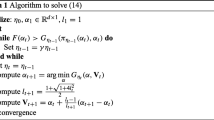Abstract
An online hidden feature extraction algorithm is proposed for unknown and unstructured agricultural environments based on a supervised kernel locally linear embedding (SKLLE) algorithm. Firstly, an online obtaining method for scene training samples is given to obtain original feature data. Secondly, Bayesian estimation of the a posteriori probability of a cluster center is performed. Thirdly, nonlinear kernel mapping function construction is employed to map the original feature data to hyper-high-dimensional kernel space. Fourthly, the automatic determination of hidden feature dimensions is performed using a local manifold learning algorithm. Then, a low-level manifold computation in hidden space is completed. Finally, long-range scene perception is realized using a 1-NN classifier. Experiments are conducted to show the effectiveness and the influence of parameter selection for the proposed algorithm. The kernel principal component analysis (KPCA), locally linear embedding (LLE), and supervised locally linear embedding (SLLE) methods are compared under the same experimental unstructured agricultural environment scene. Test results show that the proposed algorithm is more suitable for unstructured agricultural environments than other existing methods, and that the computational load is significantly reduced.









Similar content being viewed by others
References
Ahuja S, Iles P, Waslander SL (2016) Three-dimensional scan registration using curvelet features in planetary environments. J Field Robot 33(2):243–259
Bietresato M, Carabin G, Vidoni R et al (2016) Evaluation of a LiDAR-based 3D-stereoscopic vision system for crop-monitoring applications. Comput Electron Agric 124:1–13
de Ridder D, Kouropteva O, Okun O et al (2003) Supervised locally linear embedding. Artificial neural networks and neural information processing—ICANN/ICONIP 2003. Springer, Berlin, Heidelberg, pp 333–341
Fang HC, Ong SK, Nee AYC (2014) Novel AR-based interface for human-robot interaction and visualization. Adv Manuf 2(4):275–288
Fjeldaas S (2014) Computer vision supported by 3D geometric modelling. Adv Manuf 2(1):22–31
Hadsell R, Sermanet P, Ben J et al (2009) Learning long-range vision for autonomous off-road driving. J Field Robot 26(2):120–144
Jackel LD, Krotkov E, Perschbacher M et al (2006) The DARPA LAGR program: goals, challenges, methodology, and phase I results. J Field Robot 23(11–12):945–973
Jamali A, Rahman AA, Boguslawski P et al (2017) An automated 3D modeling of topological indoor navigation network. GeoJournal 82(1):157–170
Jensen MAF, Bochtis D, Sørensen CG et al (2012) In-field and inter-field path planning for agricultural transport units. Comput Ind Eng 63(4):1054–1061
Kraus T, Ferreau HJ, Kayacan E et al (2013) Moving horizon estimation and nonlinear model predictive control for autonomous agricultural vehicles. Comput Electron Agric 98:25–33
Liu H, Taniguchi T, Tanaka Y et al (2017) Visualization of driving behavior based on hidden feature extraction by using deep learning. IEEE Trans Intell Transp Syst 18(9):2477–2489
Lunga D, Prasad S, Crawford MM et al (2014) Manifold-learning-based feature extraction for classification of hyperspectral data: a review of advances in manifold learning. IEEE Signal Process Mag 31(1):55–66
Matveev AS, Hoy M, Katupitiya J et al (2013) Nonlinear sliding mode control of an unmanned agricultural tractor in the presence of sliding and control saturation. Rob Auton Syst 61(9):973–987
Mehta SS, Burks TF, Dixon WE (2008) Vision-based localization of a wheeled mobile robot for greenhouse applications: a daisy-chaining approach. Comput Electron Agric 63(1):28–37
Milella A, Reina G (2014) 3D reconstruction and classification of natural environments by an autonomous vehicle using multi-baseline stereo. Intel Serv Robot 7(2):79–92
Mousazadeh H (2013) A technical review on navigation systems of agricultural autonomous off-road vehicles. J Terrramech 50(3):211–232
Niesterowicz J, Stepinski TF (2013) Regionalization of multi-categorical landscapes using machine vision methods. Appl Geogr 45:250–258
Noguchi N, Will J, Reid J et al (2004) Development of a master–slave robot system for farm operations. Comput Electron Agric 44(1):1–19
Procopio MJ, Mulligan J, Grudic G (2009) Learning terrain segmentation with classifier ensembles for autonomous robot navigation in unstructured environments. J Field Robot 26(2):145–175
Roweis ST, Saul LK (2000) Nonlinear dimensionality reduction by locally linear embedding. Science 290(5500):2323–2326
Schölkopf B, Smola A, Müller KR (1997) Kernel principal component analysis. In: International conference on artificial neural networks. Springer, pp 583–588
Schölkopf B, Smola A, Müller KR (1998) Nonlinear component analysis as a kernel eigenvalue problem. Neural Comput 10(5):1299–1319
Si YS, Liu G, Feng J (2015) Location of apples in trees using stereoscopic vision. Comput Electron Agric 112:68–74
Zhang W, Chen Q, Zhang W et al (2018) Long-range terrain perception using convolutional neural networks. Neurocomputing 275:781–787
Acknowledgements
This paper was sponsored by the National Natural Science Foundation of China (Grant No. 51375293) and the Basic Research of the Science and Technology Commission of Shanghai Municipality (Grant No. 12JC1404100).
Author information
Authors and Affiliations
Corresponding author
Rights and permissions
About this article
Cite this article
Miao, ZH., Ma, CH., Gao, ZY. et al. Hidden feature extraction for unstructured agricultural environment based on supervised kernel locally linear embedding modeling. Adv. Manuf. 6, 409–418 (2018). https://doi.org/10.1007/s40436-018-0227-8
Received:
Accepted:
Published:
Issue Date:
DOI: https://doi.org/10.1007/s40436-018-0227-8




